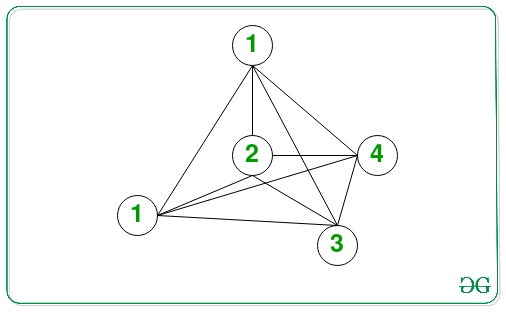给定一个由N 个节点组成的图,其中每个节点代表一次考试和一个二维数组Edges[][2] ,使得每对考试(Edges[i][0], Edges[i][1])表示它们之间的边缘,任务是找到安排所有考试所需的最少天数,这样通过边缘连接的两个考试不会安排在同一天。
例子:
Input: N = 5, E = 10, Edges[][] = {{0, 1}, {0, 2}, {0, 3}, {0, 4}, {1, 2}, {1, 3}, {1, 4}, {2, 3}, {2, 4}, {3, 4}}
Output: 5
Explanation:

In the above graph, all the nodes (representing exams) are connected to each other via a directed path. Therefore, the minimum number of days required to complete the exam is 5.
Input: N = 7, E = 12, Edges[][] = [{0, 1}, {0, 3}, {0, 4}, {0, 6}, {1, 2}, {1, 4}, {1, 6}, {2, 5}, {2, 6}, {3, 4}, {3, 5}, {4, 5}]
Output: 3
方法:给定的问题可以通过使用图着色的概念来解决。请按照以下步骤解决给定的问题:
- 从图中给定的 Edges[][] 创建一个邻接矩阵。
- 初始化一个成对向量,比如vdegree[] ,它存储每个节点与节点的度数。
- 计算每个顶点的度数并将其存储在数组vdegree[] 中。
- 按度数降序排列vdegree[]中的所有顶点。
- 初始化两个 数组,比如color[]和coloured[]来存储用于着色顶点的颜色以及顶点是否已着色。
- 初始化两个变量,例如numvc和K为0 ,以跟踪分配给每个节点的着色顶点数量和颜色编号。
- 使用变量i在范围[0, V] 上迭代并执行以下步骤:
- 如果 numvc的值与V相同,则在所有顶点都着色时跳出循环。
- 如果当前顶点是彩色的,则继续迭代。
- 如果顶点没有着色,则使用颜色K为顶点着色为 coloured[vdegree[i]] = color[K]并增加numvc的值。
- 迭代范围[0, V] ,如果当前顶点未着色且与节点i不相邻,则使用颜色K为当前节点着色并增加numvc的值。
- 将 K的值增加1 。
- 按递增顺序对数组 coloured[] 进行排序。
- 完成上述步骤后,将数组 coloured[] 中存在的唯一元素数的值打印为最小天数。
下面是上述方法的实现:
C++14
// C++ program for the above approach
#include
using namespace std;
// Comparator function to sort the
// vector of pairs in decreasing order
bool compare(pair a,
pair b)
{
// If the first values are the same
if (a.first == b.first) {
return (a.second < b.second);
}
// Otherwise
else {
return (a.first > b.first);
}
}
// Function to add an undirected
// edge between any pair of nodes
void addEdge(vector >& adj,
int u, int v)
{
adj[u][v] = 1;
adj[v][u] = 1;
}
// Function to find the minimum number
// of days to schedule all the exams
int minimumDays(int V, int Edges[][2],
int E)
{
// Stores the adjacency list of
// the given graph
vector > adj(
V, vector(V, 0));
// Iterate over the edges
for (int i = 0; i < E; i++) {
int u = Edges[i][0];
int v = Edges[i][1];
// Add the edges between the
// nodes u and v
addEdge(adj, u, v);
}
// Initialize a vector of pair that
// stores { degree, vertex }
vector > vdegree(V);
for (int i = 0; i < V; i++) {
// Degree of the node
int degree = 0;
vdegree[i].second = i;
for (int j = 0; j < V; j++) {
if (adj[i][j] != 0) {
// Increment the degree
degree++;
}
}
// Update the degree of the
// current node
vdegree[i].first = degree;
}
// Sort to arrange all vertices
// in descending order of degree
sort(vdegree.begin(),
vdegree.end(), compare);
// Stores the vertices according
// to degree in descending order
int vorder[V];
for (int i = 0; i < V; i++) {
vorder[i] = vdegree[i].second;
}
// Stores the color of the all
// the nodes
int color[V];
for (int i = 0; i < V; i++) {
color[i] = i + 1;
}
int colored[V];
// Initialize all vertices with
// an invalid color 0
memset(colored, 0, sizeof(colored));
// Keeps the track of number of
// vertices colored
int numvc = 0;
// Track the different color
// assigned
int k = 0;
for (int i = 0; i < V; i++) {
// If all vertices are colored
// then exit from the for loop
if (numvc == V) {
break;
}
// If vertex is already
// colored, then continue
if (colored[vorder[i]] != 0) {
continue;
}
// If vertex not colored
else {
colored[vorder[i]] = color[k];
// After coloring increase
// the count of colored
// vertex by 1
numvc++;
for (int j = 0; j < V; j++) {
// If the current node
// and its adjacent are
// not colored
if (colored[j] == 0
&& adj[vorder[i]][j] == 0) {
colored[j] = color[k];
// Increment the count
numvc++;
}
}
// Increment k
k++;
}
}
// Sort the array
sort(colored, colored + V);
// Count of unique colors
int unique_color = 1;
// Count the number of unique
// colors
for (int i = 1; i < V; i++) {
if (colored[i]
!= colored[i - 1]) {
unique_color++;
}
}
// Return the number of days
// to sechedule an exam
return unique_color;
}
// Driver Code
int main()
{
int V = 7, E = 12;
int Edges[][2]
= { { 0, 1 }, { 0, 3 }, { 0, 4 }, { 0, 6 }, { 1, 2 }, { 1, 4 }, { 1, 6 }, { 2, 5 }, { 2, 6 }, { 3, 4 }, { 3, 5 }, { 4, 5 } };
cout << minimumDays(V, Edges, E);
return 0;
} 3
时间复杂度: O(N 2 )
辅助空间: O(N)
如果您希望与专家一起参加现场课程,请参阅DSA 现场工作专业课程和学生竞争性编程现场课程。